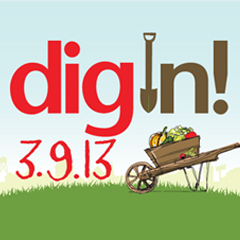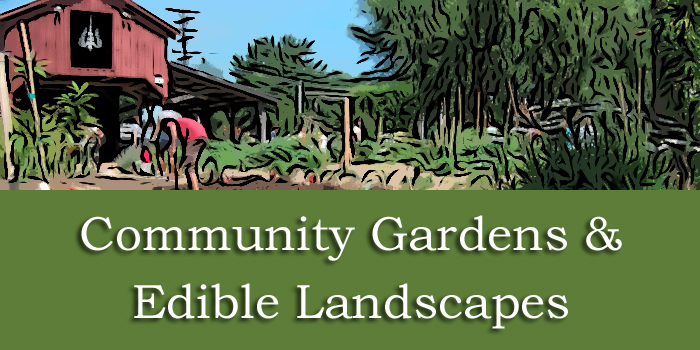 On Saturday, March 9th I attended a fantastic program called “Dig In” created by the Advocates for Health in Action (AHA). If you don’t know who AHA is – they work across our community to promote healthy eating and physical activity – or, as they say, finding ways to make the healthy choice the easy choice!
On Saturday, March 9th I attended a fantastic program called “Dig In” created by the Advocates for Health in Action (AHA). If you don’t know who AHA is – they work across our community to promote healthy eating and physical activity – or, as they say, finding ways to make the healthy choice the easy choice!
This seminar offered me an opportunity to combine some of my passions – environmental issues, healthy choices and fun. I had high expectations, and was not disappointed.
The main topic was “Weaving Edible Landscapes-Community Gardens and Urban Ag into the Fabric of our Community.” Given Cary’s recent ordinance change and allowance of Chickens and Beekeeping, I think it’s fair to say that our community is in line with some of the trends towards more locally grown food, and a new focus on nutrition.
It was nice to see that folks from both from the City of Raleigh and Town of Cary in attendance – specifically Emily Barrett, our Town’s sustainability manager. This trend and the topic of discussion really spoke to me. Not only as a council member, but also personally as I start the move away from processed foods, getting ready to plant my garden for the season, and finding ways to bring these lessons home to my family.
To get a taste of what has been done in England, check out this TED video (13 minutes – well worth it!) that was shared. It’s by Pam Warhurst – “How we can eat our landscapes.” She cofounded “Incredible Edible, an initiative in England that is dedicated to growing food locally by planting on unused land in the community.
What I learned
Ok, a lot. The first session was a kickoff by Professor Robin Moore and Dr. Nilda Cosco from the Natural Learning Initiative, and the NC State University and College of Design.
They gave us a global look into how “foodscapes have been transforming communities for the better.” Taking us on a tour of Japan, to Hong Kong, then Europe, and then to some urban growing areas in the US (Chicago, Greensboro and more ) with a specific focus on how community gardens are popping up in schools, parks, and across our country.
Highlights
- Urban farmers account for 25% of farming households in Japan.
- In Tokyo, local agriculture produces enough vegetable to feed almost 700,000, grown on rooftops and in basements.
- Urban fields are the most productive kind of agriculture per area.
- Urban Gardens are good for city economic health & health of residents, as well as providing civic & social engagement.
- Every $1 spent at a farmers market = $.60 spent at nearby businesses.
- There is an Edible Schoolyard at the Greensboro Children’s museum that offers interactive experiences for kids with a focus on fresh seasonal food, health, wellness and outdoor play. (Check out their blog.)
What can I take from this?
First, I wanted to see what we are doing at the Town of Cary around these ideas. So I connected with our Parks, Recreation and Cultural Resources team – to let them know of the wealth of information and experience of the folks that attended, and to learn more of our plans, and what else we can do. As you may know, the new Carpenter Park that was approved with our recent Bond Referendum has a “Community Garden” as part of the design. I think it’s probably the first Town sponsored/supported garden on Public property in Cary. (I might be wrong.)
I’d also like to see more focus on resources to help local gardeners – whether it’s through the Town of Cary or by referring people to our local cooperatives or other programs. I was lucky enough to meet the leaders of the Kirk of Kildaire garden and the folks at the local YMCA with a garden there. There is also the local Cary Pocket Garden, that is lead by a former Hometown Spirit Award winner, Keith Bliss. Each of these gardens is doing so much to improve the story of our community, by giving back local food to those who need it.
Garden Time
 One of the cool tricks I learned was from a lovely lady showing off how she re-uses all types of containers – creating little terrariums to start seedlings. She takes a cleaned out Liter bottle (I used a Diet Mountain Dew bottle, but she had bottles of Simply Orange, Diet Pepsi, and many others) and does the following.
One of the cool tricks I learned was from a lovely lady showing off how she re-uses all types of containers – creating little terrariums to start seedlings. She takes a cleaned out Liter bottle (I used a Diet Mountain Dew bottle, but she had bottles of Simply Orange, Diet Pepsi, and many others) and does the following.
- Clean out the bottle and take off the label (if possible)
- Poke a number of holes in the bottom (for drainage)
- Cut the bottle in half, but not all the way across. Leave a bit of the bottle attached, and fold back the top half.
- Fill the bottom portion with potting soil and soak the soil till wet and dripping through.
- Add your seeds, cover lightly with vermiculite if you have it. Spray water using a spray bottle to wet the top.
- Fold the top back over and use clear packing tape to tape it back up.
- Put it outside or on your counter – spray in water in as needed.
Your seedlings will sprout pretty quickly. And you just cut the tape, gently turn over the bottle and you will have your seedlings to plant! How cool is that?
My basil has sprouted already – and I’ve started a few more since then.
Get Started – Get Good Dirt for Free!

Photo by Kirsty Hall
This weekend you can get a start on your own garden. On Saturday, March 23rd the Town of Cary has a Compost Giveaway! Come out to the Garmon Operations Center at 400 James Jackson Ave. from 9:00 a.m. to 1 p.m. and get some compost.
All you have to do is to bring your own hard sided container. I’ll be bringing my recycle container and some other same size boxes to fill my little garden up. (It should be between 18 and 32 gallons.) If you want more than that and have a pickup truck, you will be placed in a different line to get your compost.
My goal is to learn more about this and maybe create my own compost bin soon. Stay tuned.
And, if you have tips, techniques or are a master gardener…maybe you can help me? 🙂
Post posting note: Here is a link to the resources from the conference – feel free to check them out.
Featured image from the Greensboro Edible Schoolyard blog


One Response to Diggin’ In